Czech dialects
Linguonym
- Kłodzko dialect (of Czech language) ~ Kudowa dialect/dialect,
- Dialect/dialect of Zelów and Kuców
- kladské nářečí (jazyka českého) ~ nářečí z okolí Chudoby,
- nářečí z Zelova a Kucova.
History and geopolitics
Location – presently and before
Czechs are one of the nine minorities officially recognized in Poland; the group is almost 3,000 people in number. The majority of them are considerably dispersed. Historically speaking, one can enumerate a few areas of the Polish lands that were inhabited by the Czechs:- an enclave that included Zelów, Kuców and the surroundings (presently Łódź Voivodeship)
- the region of Kłodzko Valley (Silesian Voivodeship)
- Western part of Cieszyn Silesia (Silesian Voivodeship)
- Leszno and the surrounding areas (Greater Poland Voivodeship)
- Wołyń (former Kresy)
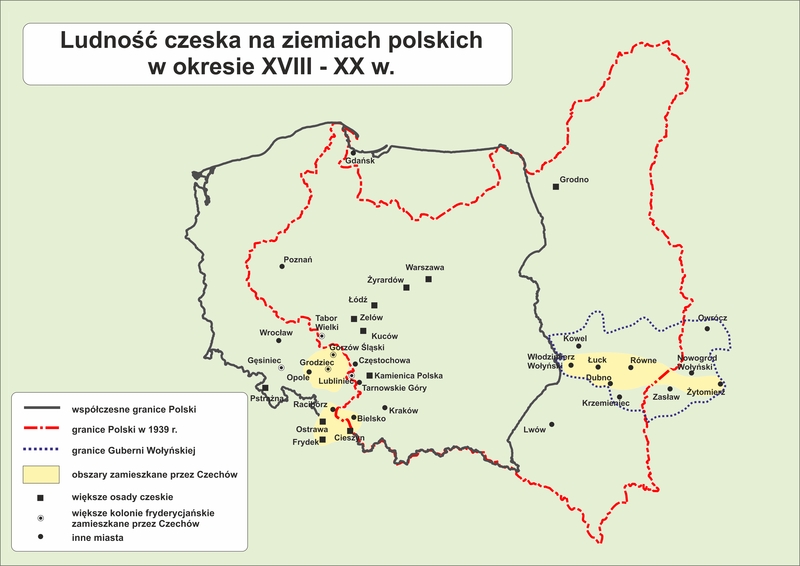
Czech settlements in the territory of Poland (map ed.: Jacek Cieślewicz, based on: Tobjański 1994: 32
 Tobjański 1994 / komentarz/comment/r /
Tobjański 1994 / komentarz/comment/r / Tobjański, Zbigniew 1994. Czesi w Polsce. Kraków: Towarzystwo Społeczno-Kulturalne Czechów i Słowaków w Polsce.
 ).
).The most numerous and linguistically active group of Czechs in Poland inhabits Zelów (Czech Zelov) which is situated in Bełchatów district of Łódź Voivodeship. Presently, there are ca. 8,000 inhabitants in the town itself, and almost 15,000 people in the surrounding district.
The ancestors of the Czech people from Zelów arrived in Poland on the turn of 1802 and 1803, when they bought the town from its owner, Jan Świdziński. The new inhabitants of Zelów were primarily Evangelicals who escaped from their country as a result of religious prosecutions of Czech Brethren. Zelów was developing fast in the first half of the 19th century. It was possible because of the arrival of qualified workers from the Czech Republic who initiated the domestic textile industry in the town (in 1846, for out of 156 of local farmers 109 of them worked also as weavers. In the second half of the 19th century, Poles, Jews and Germans started to settle there in larger numbers as well, which changed Zelów’s character to make it multiethnic (Oszczęda 2010
 Oszczęda 2010 / komentarz/comment/r /
Oszczęda 2010 / komentarz/comment/r / Oszczęda, Waldemar Ireneusz 2010. „Największy ośrodek mniejszości czeskiej w Polsce”, Top – Tygodnik Opoczyński 43 (694). URL: http://www.opoczno-top.pl/artykul,Najwiekszy_osrodek_mniejszosci_czeskiej_w_Polsce,3962.html [dostęp: 15.12.2012 r.].
 ; Gawliczek 2012: 16
; Gawliczek 2012: 16 Gawliczek 2012 / komentarz/comment/r /
Gawliczek 2012 / komentarz/comment/r / Gawliczek, Krzysztof 2012. „Historia mniejszości czeskiej na ziemiach polskich oraz różnice w interpretacji wzajemnej historii między Polakami a Czechami”, w: Lech M. Nijakowski (red.) Czesi, seria „Mniejszości narodowe i etniczne w Polsce”. Warszawa: Wydawnictwo Sejmowe.
 ; Góral et al. 1987: 17
; Góral et al. 1987: 17 Góral et al. 1987 / komentarz/comment/r /
Góral et al. 1987 / komentarz/comment/r / Góral, Jan & Ryszard Kotewicz & Zbigniew Tobjański 1987. Zarys dziejów Zelowa. Zelów: Urząd miasta i gminy Zelów.
 ).
).
Coat of arms of Zelów.
Copyright under Creative Commons/GNU http://en.wikipedia.org/wiki/File:POL_Zel%C3%B3w_COA.svg
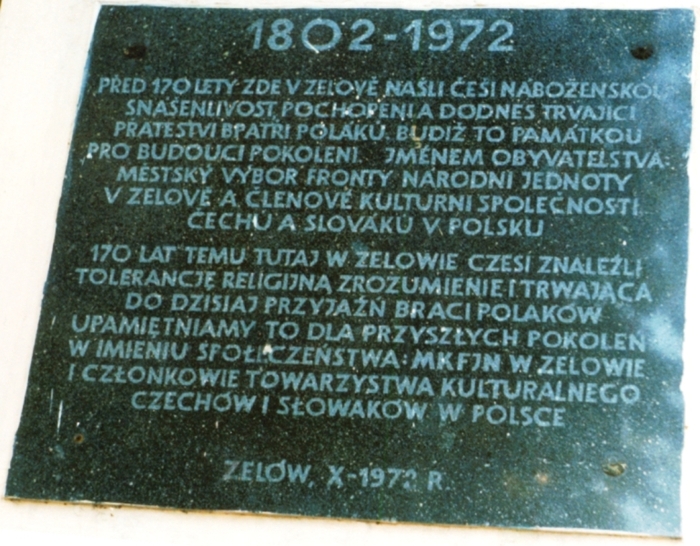
Bilingual plaque in Zelów, photo. T. Wicherkiewicz.
In 1818, Czech settlers established the village of Kuców, 30km to the south of Zelów (it does not exist any longer). The neighbouring villages, Folwark, Aleksandrów and Żłobnica, were settled as well. In 1852, a parish of the Reformed Church in Zelów was established, and in 1896 a new church of this faith built. Between 1970 and 1991, the population of the region was resettled in Bełchatów and Kleszczów as a result of preparations for the liquidation of the village and building a lignite coal quarry (Dejna 1190: 5f
 Dejna 1990 / komentarz/comment/r /
Dejna 1990 / komentarz/comment/r / Dejna, Karol 1990. Słownik gwary czeskiej mieszkańców Kucowa. Wrocław: Ossolineum.
 ).
).Apart from Zelów and Kuców, Czechs live mainly in the town and and district of Kamienica Polska (Silesian Voivodeship, Częstochowa district) and Żyrardów (Masovian Voivodeship, Żyrardów district), as well as in Łódź and Warsaw. They migrated to those places mainly between 1833 and 1840).
A second place in terms of concentrated numbers of Czech inhabitants can be found in the Lower Silesian and the Silesian Voivodeships, in the Kłodzko Valley region, and in Cieszyn Silesia (primarily around Racibórz). Many Czech inhabitants are the descendants of the Czech intellectuals who settled in Greater Poland (chiefly in Leszno and Ostroróg) in the 15th and 16th centuries. Afterwards, ca. 25,000 Czechs moved from Greater Poland to Silesia, joining a small group of Czech who already lived there. This was a part of so-called Frederitian colonization. In 1840, they constituted ca. 40% of the inhabitants of Racibórz district. In 1945, almost all of them were expatriated, but officially the displacement of people was supposed to concern only the Germans (Lubos 1974: 29ff
 Lubos 1974 / komentarz/comment/r /
Lubos 1974 / komentarz/comment/r / Lubos, Arno 1974. „Das tschechische Volkstum in der Grafschaft Glatz”, w: Deutsche und Slawen. Wiedeń: Europaverl.
 ; Gawliczek 2012: 16ff
; Gawliczek 2012: 16ff Gawliczek 2012 / komentarz/comment/r /
Gawliczek 2012 / komentarz/comment/r / Gawliczek, Krzysztof 2012. „Historia mniejszości czeskiej na ziemiach polskich oraz różnice w interpretacji wzajemnej historii między Polakami a Czechami”, w: Lech M. Nijakowski (red.) Czesi, seria „Mniejszości narodowe i etniczne w Polsce”. Warszawa: Wydawnictwo Sejmowe.
 ).
).The area of Poland inhabited by Czech migrants (Silesian and Lower Silesian Voivodeships) which is situated near the present border with the Czech Republic, is often called the Czech corner (Czech: Český koutek, Ger. Böhmischen Winkel). The Czech corner is located to the south-west of Błędne Skały (near Kudowa-Zdrój, between Lewino and Náchod in the Czech Republic). The area comprises of the following towns:
| ● | Czermna | (Cz. Velká Čermná, Ger. Tscherbeney), |
| ● | Bukowina | (Cz. Bukovina, Ger. Bukowine), |
| ● | Słone | (Cz. Slané, Ger. Schlaney), |
| ● | Pstrążna | (Cz. Stroužné, Ger. Strausseney), |
| ● | Kudowa-Zdrój | (Cz. Lázně Chudoba), |
| ● | Jakubowice i Brzozowie | (Cz. Jakubovice, Ger. Jakobowitz, Cz. Březová, Ger. Brzesowie, Presently districts of Kudowy-Zdroju), |
| ● | Błażejów | (Cz. Blažejov, Ger. Blasdorf b. Schömberg), |
| ● | Zakrze | (Cz. Žakš, Ger. Sackisch), |
| ● | Krzyżanów | (Cz. Křížanov, Ger. Krzischney), |
| ● | Leśna | (Cz. Lestný, Ger. Löschney), |
| ● | Jeżowice | |
| ● | Ostra Góra | (Cz. Nouzín or Ostrá Hora, niem. Nauseney). |

The Czech corner - map ed.: Jacek Cieślewicz..
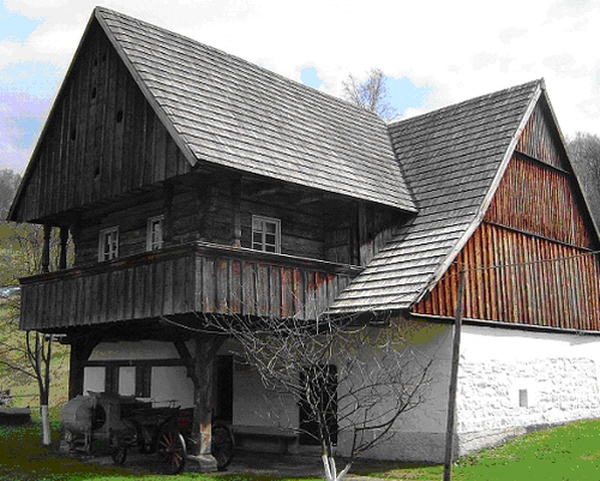
Picture of a house in Pstrążna. Photo. T. Wicherkiewicz.
The aforementioned first migration of Czech people to Poland took place in the first half of the 16th century, and was a result of religious prosecutions of Czech Brethren. The next waves of migration occurred respectively in the first half of the 17th century and the second half of the 18th century. However, the majority of Czechs who live in Poland now, arrived in the country at the beginning of the 19th century, also because of religious persecutions. They settled down in the present day Łódź Voivodeship, mainly in Zelów. Some of them assimilated into Polish society, but the majority retained their mother tongue (i.e. a variety of the Czech language), along with their traditions and their Evangelical-Reformed faith. From the political viewpoint of the Second Polish Republic, a small Czech group did not matter much, therefore there were no attempts to Polonize the Zelów enclave (Krajewska-Kułak & Łukaszuk 2010: 83ff
 Krajewska-Kułak & Łukaszuk 2010 / komentarz/comment/r /
Krajewska-Kułak & Łukaszuk 2010 / komentarz/comment/r / Krajewska-Kułak, Elżbieta & Cecylia Regina Łukaszuk 2010. „Wielokulturowość społeczeństwa polskiego”, w: Elżbieta Krajewska-Kułak & Irena Wrońska & Kornelia Kędziora-Kornatowska (red.) Problemy wielokulturowości w medycynie. Warszawa: Wydawnictwo Lekarskie PZWL. URL: http://www.wydawnictwopzwl.pl/download/229290100.pdf [dostęp: 15.12.2010 r.].
 ).
).The situation was different for 31,000 Czech people who settled in Wołyń after the abolition of serfdom between 1860 and 1870. Although they converted to the Orthodox faith, they retained their language and traditions. After the Second Republic of Poland had been created, Czechs were permitted to establish schools with Czech as a teaching language which helped to cultivate Czech traditions in social life (Tomaszewski 1985: 158ff
 Tomaszewski 1985 / komentarz/comment/r /
Tomaszewski 1985 / komentarz/comment/r / Tomaszewski, Jerzy 1985. Ojczyzna nie tylko Polaków. Warszawa: Młodzieżowa Agencja Wydawnicza.
 ). As stated by Tomaszewski in his book (1985: 159f
). As stated by Tomaszewski in his book (1985: 159f Tomaszewski 1985 / komentarz/comment/r /
Tomaszewski 1985 / komentarz/comment/r / Tomaszewski, Jerzy 1985. Ojczyzna nie tylko Polaków. Warszawa: Młodzieżowa Agencja Wydawnicza.
 ):
):Wealth allowed them to retain individuality, and even to live separately from society. The Czech population – both in Łódź and Wołyń Voivodeships – did not take part in political life. Polish authorities treated cultivation of the mother tongue and keeping contact with Czech lands as a sign of chauvinism, even though the Czechs declared their loyalty towards Poland. (…) in a study about Czech people from Wołyń it was claimed that: “Politically unified, keeping up appearances regarding their utter submission to Poland, the Czech population is an element which does not assimilate, and is also immune to subversive propaganda. However, its solidification into one body which is subject to the directives of the foreign head offices, makes it a regular foreign body in a consolidated organism”. So, the author of the memorial postulated restriction for Czech organizations, a reduction in the number of schools, and he recommended obstructing departures to Czechoslovakia, and forcing Czechs to join mixed-nationality organizations. In fact, it boiled down to creating pressure which would help assimilate Czechs.

Czech colonies in Wołyń in the second half of the 19th, and the first half of the 20th century (map ed.: Jacek Cieślewicz, after: Tobjański 1994: 57
 Tobjański 1994 / komentarz/comment/r /
Tobjański 1994 / komentarz/comment/r / Tobjański, Zbigniew 1994. Czesi w Polsce. Kraków: Towarzystwo Społeczno-Kulturalne Czechów i Słowaków w Polsce.
 ).
).Until the beginning of World War II, there were 50 Czech colonies and smaller concentration of Czechs in ca. 500 other towns in Wołyń. The Czechs from Wołyń were loyal citizens of the Republic of Poland – after the outbreak of World War II, their anti-German organization “Blanik” was active in 102 towns. They were neutral in Polish-Ukrainian conflicts; however, they frequently joined the Polish guerrilla, whereas Ukrainian organizations of this kind succeeded in recruiting only 10 Czech people. In 1943-1944 in Wołyń, Ukrainian nationalists committed an ethic purge (also known as the Wołyń slaughter), in which – apart from other nationalities – ca. 342 Czech people were murdered (Solak 2005
 Solak 2005 / komentarz/comment/r /
Solak 2005 / komentarz/comment/r / Solak, Andrzej 2005. „Zbrodnia w Malinie. Cz. 1”, Głos Kresowian 20. Warszawa: KRP.
 ).
).Czech population in The Kingdom of Poland and in Wołyń (1850-1913) (Tobjański 1994: 51 Tobjański 1994 / komentarz/comment/r /
Tobjański 1994 / komentarz/comment/r /
Tobjański, Zbigniew 1994. Czesi w Polsce. Kraków: Towarzystwo Społeczno-Kulturalne Czechów i Słowaków w Polsce.
 ).
).
 Tobjański 1994 / komentarz/comment/r /
Tobjański 1994 / komentarz/comment/r / Tobjański, Zbigniew 1994. Czesi w Polsce. Kraków: Towarzystwo Społeczno-Kulturalne Czechów i Słowaków w Polsce.
 ).
).| year | The Kingdom of Poland | Wołyń | together |
| 1850 | 5027 | 2844 | 7871 |
| 1897 | 4986 | 23143 | 28143 |
| 1913 | 6450 | 26520 | 32970 |
The Czech population in Wołyń in 1921 by districts (Tobjański 1994: 117 Tobjański 1994 / komentarz/comment/r /
Tobjański 1994 / komentarz/comment/r /
Tobjański, Zbigniew 1994. Czesi w Polsce. Kraków: Towarzystwo Społeczno-Kulturalne Czechów i Słowaków w Polsce.
 ).
).
 Tobjański 1994 / komentarz/comment/r /
Tobjański 1994 / komentarz/comment/r / Tobjański, Zbigniew 1994. Czesi w Polsce. Kraków: Towarzystwo Społeczno-Kulturalne Czechów i Słowaków w Polsce.
 ).
).| District | Acc. to the 1921 census | Acc. to Z. Cichocka[6 przyp06 / komentarz/comment / przyp06 / komentarz/comment / Dane te pochodzą ze źródła cytowanego przez Tobjańskiego (1994: 117): Cichocka-Petrażycka, Zofia 1939. „Kolonie niemieckie i czeskie na Wołyniu”, Rocznik Ziem Wschodnich 5: 59. Warszawa.  ] ] |
| Dubień | 10 200 | 10 861 |
| Równień | 7 567 | 6 744 |
| Łuc | 4 843 | 4 540 |
| Horochow | 906 | 926 |
| Kowel | 982 | 987 |
| Włodzimierz | 322 | 393 |
| Krzemieniec | 253 | 87 |
| Overall | 25 073 | 24 538 |
Location – outside of the Republic of Poland
Dialects of Czech language in Poland are different from the dialects which can be found in the Czech Republic. They are closely related to North-East dialects of Czech, and their users live in the region of Kłodzko Valley and Cieszyn Silesia (Wróblewski 2012: 50 Wróblewski 2012 / komentarz/comment/r /
Wróblewski 2012 / komentarz/comment/r / Wróblewski, Piotr 2012. „Kim są zelowscy Czesi?”, w: Lech M Nijakowski (red.) Czesi, seria „Mniejszości narodowe i etniczne w Polsce”. Warszawa: Wydawnictwo Sejmowe.
 ; Dejna 1990: 5ff
; Dejna 1990: 5ff Dejna 1990 / komentarz/comment/r /
Dejna 1990 / komentarz/comment/r / Dejna, Karol 1990. Słownik gwary czeskiej mieszkańców Kucowa. Wrocław: Ossolineum.
 ).
).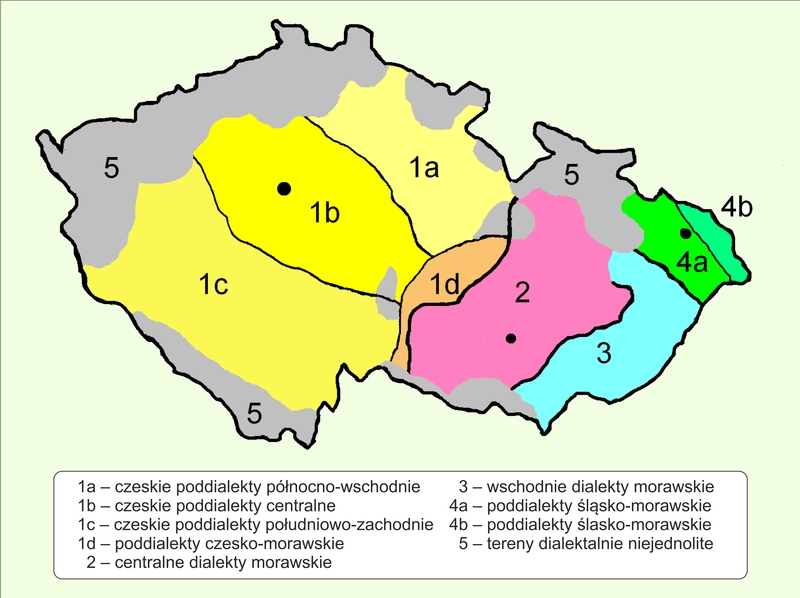
map ed.: Jacek Cieślewicz, on the basis of: http://upload.wikimedia.org/wikipedia/commons/e/e8/Czech_dialects.PNG.
History
The earliest information about the Czech-speaking population in present day Poland comes from the 13th and 14th centuries. The sources mention Czech peasants who lived in the part of Silesia close the border (yet, it is worth pointing out that the area of the present day Kłodzko Valley was inhabited by Czech natives as early as in the 11th century).However, a significant inflow of Czechs to Silesia did not take place until the 18th century. Ca. 5,000 people of Czech Brethren moved to Silesia after the Habsburgs’ victory over the forces of the Czech national and religious movement in the Battle of White Mountain in 1620. In February 1742, 30 Czech arrived in Ziębice (Ger. Münsterberg; presently Ząbkowice district, Lower Silesian Voivodeship), in March 231 people more, and in May of that year additional 1110. The majority of the immigrants came from the following towns: Náchod, Opočno (Opoczno), Nové Město, Poděbrady (Podiebrady), Smiřice, Litomyšl, and Lanškroun. The Czech colonization of the area, aimed mainly at Syców, Strzelin and Opole, took place to 1840s. In 1840, 32,743 Czech people lived in the present day Racibórz district, and 10,793 of them in the Głubczyce district (which constituted respectively of 39% and of 16% of the population in the two regions). In the following years, the number of Czechs regularly decreased. According to official data, the Czech population constituted merely 5.4% of the overall population of Głubczyce district in 1910. This data, however, are disputable, because some of the inhabitants of the linguistic border were bilingual (i.e. they spoke both Polish and Czech), which made their sense of national identity ambiguous.
A group of Czechs – which consisted of nearly as many people as the group which migrated to Silesia – settled in Cieszyn Silesia. It is estimated that ca. 29,000 Czechs lived there in 1840. Although their percentage share in the region decreased with the inflow of other nationalities, their absolute number increased until the beginning of the 19th century (Tobjański 1994: 27ff
 Tobjański 1994 / komentarz/comment/r /
Tobjański 1994 / komentarz/comment/r / Tobjański, Zbigniew 1994. Czesi w Polsce. Kraków: Towarzystwo Społeczno-Kulturalne Czechów i Słowaków w Polsce.
 ).
).National groups in Prussian Silesia in 1787-1840 (Tobjański 1994: 17 Tobjański 1994 / komentarz/comment/r /
Tobjański 1994 / komentarz/comment/r /
Tobjański, Zbigniew 1994. Czesi w Polsce. Kraków: Towarzystwo Społeczno-Kulturalne Czechów i Słowaków w Polsce.
 ).
).
 Tobjański 1994 / komentarz/comment/r /
Tobjański 1994 / komentarz/comment/r / Tobjański, Zbigniew 1994. Czesi w Polsce. Kraków: Towarzystwo Społeczno-Kulturalne Czechów i Słowaków w Polsce.
 ).
).| Nationality | 1787 r. | % | 1840 r. | % |
| Poles | 401 900 | 23,0 | 646 000 | 22,8 |
| Czech | 32 600 | 1,8 | 53 000 | 1,9 |
| Germans | 1 303 300 | 74,6 | 2 066 000 | 73,1 |
| Jews | 8 900 | 0,5 | 27 000 | 1,0 |
| Others | 900 | 0,1 | 35 000 | 1,2 |
| Total | 1 747 600 | 100,0 | 2 827 000 | 100,0 |
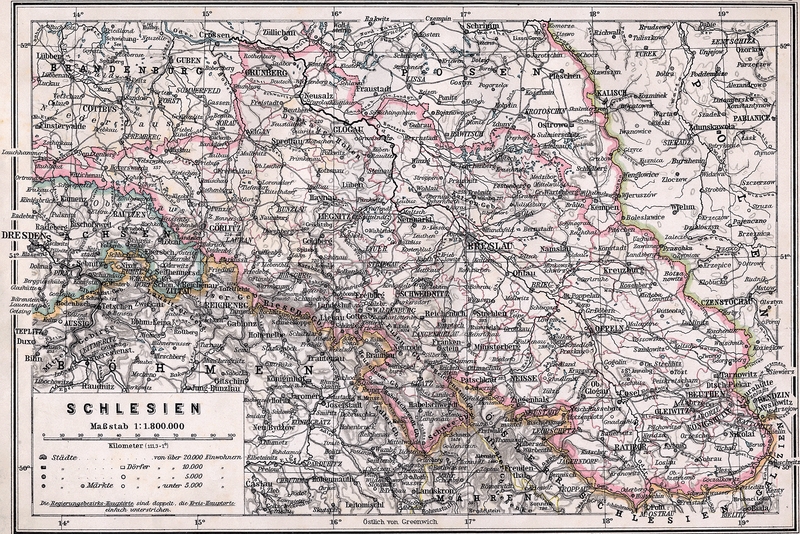
Map of the Silesian Province from 1905. Link: http://pl.wikipedia.org/wiki/Plik:Schlesien_1905.png
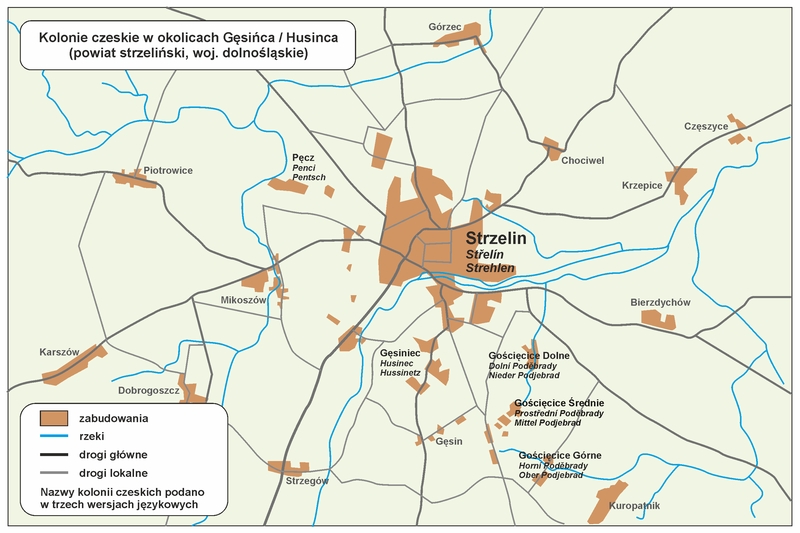
Czech settlements in the vicinities of Husinec/Gęsiniec in Lower Silesia (map ed.: Jacek Cieślewicz)
Some of the Czech immigrants settled permanently in villages around Ziębice – 190 families, and in Strzelino (hist. Strzelno, Ger. Strehlen, Czech Střelín, in Lower Silesian Voivodeship) – 28 families. In 1749, after having bought farm lands near Strzelin, a little group of Czechs established Husiniec village (named after Jan Hus; it retained the name until 1945, when it was officially changed to Gęsiniec). similarly to Zelów, Czech inhabitants made their living mainly from textile industry. The second Czech group migrated in 1752 to the royal possessions situated to the north-east to Opole. in the same year, they established colony Grodziec (Czech Bedřichov Hradec, Ger. Friedrichgrätz) with an Evangelical parish, and towns: Piotrówka (Czech Petrovice), Kamienica Polska, and Huta Stara which was bought in 1819 from Jan Trepka. An older centre of the Czech Brethren in Brzeg (Czech Břeh, Ger. Brieg)vexisted in this region; it was established in 1620. In addition, several other settlements were established in the forests to the east of Syców (Oleśnice district): Tabor Wielki (1748), Tabor Mały (1752) and Czermin (1764). However, the Czech settlers were not satisfied with the conditions they encountered there, and it was not easy to cultivate the infertile soil. Therefore, some of them moved to Zelów, Pożdżenice (in 1802), and to Kuców (Balowski 2012: 66f
 Balowski 2012 / komentarz/comment/r /
Balowski 2012 / komentarz/comment/r / Balowski, Mieczysław 2012. „Postawy Polaków wobec mniejszości czeskiej i Czechów”, w: Lech M. Nijakowski (red.) Czesi, seria „Mniejszości narodowe i etniczne w Polsce”. Warszawa: Wydawnictwo Sejmowe.
 ; Vaculík 2011: 2ff
; Vaculík 2011: 2ff Vaculík 2011 / komentarz/comment/r /
Vaculík 2011 / komentarz/comment/r / Vaculík, Jaroslav 2011. „Czechs in Lower Silesia in the 18th-20th Century”, Czech-Polish Historical and Pedagogical Journal. Brno: Masaryk University.
 ; Dejna 1990: 5f
; Dejna 1990: 5f Dejna 1990 / komentarz/comment/r /
Dejna 1990 / komentarz/comment/r / Dejna, Karol 1990. Słownik gwary czeskiej mieszkańców Kucowa. Wrocław: Ossolineum.
 ; Tobjański 1994: 25
; Tobjański 1994: 25 Tobjański 1994 / komentarz/comment/r /
Tobjański 1994 / komentarz/comment/r / Tobjański, Zbigniew 1994. Czesi w Polsce. Kraków: Towarzystwo Społeczno-Kulturalne Czechów i Słowaków w Polsce.
 ; Policar 2008
; Policar 2008 Policar 2008 / komentarz/comment/r /
Policar 2008 / komentarz/comment/r / Policar, Lukáš 2008. „Zelow – poslední česká vesnice v Polsku”, artykuł w portalu Aktuálně.cz. URL: http://blog.aktualne.centrum.cz/blogy/lukas-policar.php?itemid=5392 [dostęp: 09.01.2012 r.].
 ).
).
The number of inhabitants in Czech colonies near Husiniec in 1841-1913 (Tobjański 1994: 20 Tobjański 1994 / komentarz/comment/r /
Tobjański 1994 / komentarz/comment/r /
Tobjański, Zbigniew 1994. Czesi w Polsce. Kraków: Towarzystwo Społeczno-Kulturalne Czechów i Słowaków w Polsce.
 ).
).
 Tobjański 1994 / komentarz/comment/r /
Tobjański 1994 / komentarz/comment/r / Tobjański, Zbigniew 1994. Czesi w Polsce. Kraków: Towarzystwo Społeczno-Kulturalne Czechów i Słowaków w Polsce.
 ).
).| Towns | Number of people | |||||
| Name in Polish | Name in Czech | Name in German | 1841 | 1905 | 1908 | 1913 |
| Gęsiniec | Husinec | Hussinetz | 1551 | 1495 | 1720 | 1830 |
| Gościęcice Górne | Horní Poděbrady | Ober Podjebrad | 335 | 343 | 510 | 1200 |
| Gościęcice Średnie | Prostřední Poděbrady | Mittel Podjebrad | 476 | 270 | 290 | 320 |
| Gościęcice Dolne | Dolní Poděbrady | Nieder Podjebrad | 255 | 152 | 205 | 290 |
| Pęcz | Penci | Pentsch | 30 | 78 | 108 | 800 |
| Strzelin | Střelín | Strehlen | – | 49 | 137 | 270 |
| Overall | 2347 | 2387 | 2970 | 4710 | ||
Kamienica Polska (in the Częstochowa district) was one of the most important Czech centres in Silesia. The earliest mention about this colony dates back to 1437. It was incorporated into the Kingdom of Poland for the second time after the agreements made during the Vienna Congress in 1815. Three years later, the first wave of Czech colonizers started to settle there, and their number increased rapidly. The largest increase occurred in the second half of the 19th century; it was the result of rapid industrialization. In the following years, many Czech-speaking inhabitants of the region moved to other cities of the Kingdom of Poland (mainly to Łódź and Żyrardów, because of the development of the textile industry, and to Wołyń) and abroad, which resulted in a decline in the population (Tobjański 1994: 43ff
 Tobjański 1994 / komentarz/comment/r /
Tobjański 1994 / komentarz/comment/r / Tobjański, Zbigniew 1994. Czesi w Polsce. Kraków: Towarzystwo Społeczno-Kulturalne Czechów i Słowaków w Polsce.
 ). the table below illustrates changes in the number of inhabitants of Kamienica:
). the table below illustrates changes in the number of inhabitants of Kamienica:The population of Kamienica Polska (1827-1913) (Tobjański 1994: 44 Tobjański 1994 / komentarz/comment/r /
Tobjański 1994 / komentarz/comment/r /
Tobjański, Zbigniew 1994. Czesi w Polsce. Kraków: Towarzystwo Społeczno-Kulturalne Czechów i Słowaków w Polsce.
 ).
).
 Tobjański 1994 / komentarz/comment/r /
Tobjański 1994 / komentarz/comment/r / Tobjański, Zbigniew 1994. Czesi w Polsce. Kraków: Towarzystwo Społeczno-Kulturalne Czechów i Słowaków w Polsce.
 ).
).| The year | The number of people |
| 1827 | 590 |
| 1836 | 1194 |
| 1839 | 1420 |
| 1866 | 1471 |
| 1882 | 4370 |
| 1900 | 3028 |
| 1913 | 3734 |
As for 2007, the district is inhabited by 5466 people. Historically speaking, the town was populated by people of mixed backgrounds; it cannot be determined how many of them were of Czech origin. There is also no data on the number of the inhabitants at present.
Czech population in Wartheland and Kamienica Polska (Upper Silesian province) – December 1939 (Tobjański 1994: 167 Tobjański 1994 / komentarz/comment/r /
Tobjański 1994 / komentarz/comment/r /
Tobjański, Zbigniew 1994. Czesi w Polsce. Kraków: Towarzystwo Społeczno-Kulturalne Czechów i Słowaków w Polsce.
 )
)
(Administrational names which were introduced by the occupying authorities in Poland, and were valid from 1939 to 1945)
 Tobjański 1994 / komentarz/comment/r /
Tobjański 1994 / komentarz/comment/r / Tobjański, Zbigniew 1994. Czesi w Polsce. Kraków: Towarzystwo Społeczno-Kulturalne Czechów i Słowaków w Polsce.
 )
)(Administrational names which were introduced by the occupying authorities in Poland, and were valid from 1939 to 1945)
| German name | Present Polish name | Number of Czechs | Speakers of Czech | Speakers of languages other than Czech |
| Landkreis Lask | Łask district | 4 584 | 3 769 | 815 |
| Blachstädt | Blachownia | 2 940 | – | 2 940 |
| Landkreis Kempen | Kępiń district | 890 | 890 | – |
| Lodsch/Litzmannstadt | Łódź | 344 | 284 | 60 |
| Posen | Poznań | 60 | 59 | 1 |
| other | 70 | 58 | 11 | |
| Overall | 8 888 | 5 060 | 3 828 | |
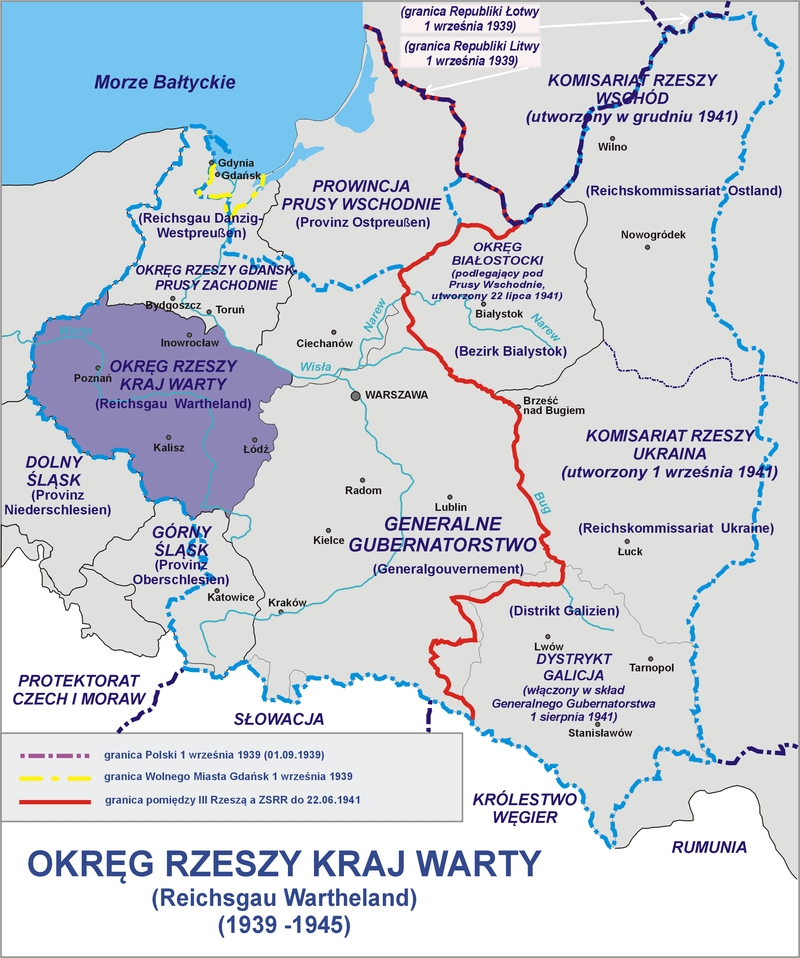
Administrational map of the Third Reich from 1939-1945 (German nomenclature). http://upload.wikimedia.org/wikipedia/commons/7/7e/Kraj_warty_1944.png
Unlike other members of Czech minority in Poland, Czechs from Kłodzko Valley (Cz. Kladská kotlina, Ger. Glatzer Kessel) were and are an autochthonic population. In 1742, the Kłodzko Valley was separated from the Czech Republic and became a part of Prussia. As a result, Czechs from the region became citizens of the Republic of Poland. Without access to Czech-language education and services, Czechs from Kłodzko were subject to Germanization which accelerated after the unification of Germany in 1871 (the same situation affected Moravians from the regions around Głubczyce and Racibórz). Because of this, Czech ethnic identity was nearly extinguished (Vaculík 2011: 2ff
 Vaculík 2011 / komentarz/comment/r /
Vaculík 2011 / komentarz/comment/r / Vaculík, Jaroslav 2011. „Czechs in Lower Silesia in the 18th-20th Century”, Czech-Polish Historical and Pedagogical Journal. Brno: Masaryk University.
 ).
).After 1945, Kłodzko and Racibórz lands were set within Polish borders. However, Czechs regarded these lands as a part of their historical heritage (according to estimations made before the war, ca. 20,000 people of Czech origin lived in the Czech corner). This belief was the basis of tensions between the governments of the People’s Republic of Poland and Czechoslovakia. Although the two parties involved in the conflict tried to draw the border since December 1942, the outcome was not satisfactory to both the Polish and Czechoslovakian sides.
Shortly after World War II, Czech people laid claims to Kłodzko land and the following districts: Prudnice, Głubczyce, and Racibórz Kozielsk. It was explained that a small number of Czechs (in the Czech corner, near Lewin Kłodzki and Kudowa-Zdrój) and Moravians (Głubczyce and Racibórz districts) still inhabited these areas. To support the claim, the Czechoslovakian army approached Kłodzko Valley and Racibórz, and in return, Polish government sent its armed forces to the line of Olza River (Czech Olše). As a result, the two armies bombarded each other’s positions for one day. In response to pressure from Moscow, Czech forces eventually retreated behind the line of the Opawa River (Czech Opava) (Pałys 2007: 15ff
 Pałys 2007 / komentarz/comment/r /
Pałys 2007 / komentarz/comment/r / Pałys, Piotr 2007. Skupiska czeskie w Kłodzkiem, Raciborskiem, Głubczyckiem i Żytawskiem wobec czechosłowackich planów zmiany granic państwowych po II wojnie światowej. Toruń: Dom Wydawniczy Duet.
 ).
).Between 1945 and 1947, Czech militia carried out regular raids into Polish lands (the present day Nysa, Kłodzko, Bystrzyca and Wałbrzych districts); the chief purpose was to confiscate the Polish flag or shoot at them. At the same time, Kladský komitét (The Kłodzko Committee) with headquarters in Náchod, was verifying applications submitted by immigrants and refugees from Kłodzko district. 5,300 people of Czech origin were registered there before the summer of 1947, and 1,329 of them applied for Czechoslovakian citizenship.
The authorities tried to solve the problem by diplomatic means – government of the People’s Republic of Poland hoped to obtain territorial concessions in Cieszyn Silesia in exchange for the cession of rights to Kłodzko Land. This led to negotiations in Prague in February 1946; however, they were fruitless. Under pressure from Moscow, Poland and Czechoslovakia signed a treaty of friendship in 1947, on the 10th of March; yet, the border issues remained unsettled (mainly those concerning Kłodzko land and Zaolzie). Governments of the two countries signed the final treaty which dealt with the border issues the 13th of June, 1958 (Pałys 2007: 46ff
 Pałys 2007 / komentarz/comment/r /
Pałys 2007 / komentarz/comment/r / Pałys, Piotr 2007. Skupiska czeskie w Kłodzkiem, Raciborskiem, Głubczyckiem i Żytawskiem wobec czechosłowackich planów zmiany granic państwowych po II wojnie światowej. Toruń: Dom Wydawniczy Duet.
 ).
).Czech population in the Regency of Opole in 1828-1861 (percentage of the overall number of citizens) (Tobjański 1994: 24 Tobjański 1994 / komentarz/comment/r /
Tobjański 1994 / komentarz/comment/r /
Tobjański, Zbigniew 1994. Czesi w Polsce. Kraków: Towarzystwo Społeczno-Kulturalne Czechów i Słowaków w Polsce.
 ).
).
Kudowa-Zdrój is a city in the Lower Silesian Voivodeship, and it is the home area of the Czech-speaking autochthons in Kłodzko Valley. In German, it is known as Bad Kudowa, and in Czech Lázně Kudova or Lázně Chudoba. Immediately after the war, the Polish name for it used to be Chudoba. Kudowa developed thanks to curative waters that were discovered there in the 17th century. Furthermore, a train line was opened, that went from Kłodzko, through Kudowa to Czech lands. Because of its historic and ethnic affiliations, Kudowa was one of the moot points between the People’s Republic of Poland and Czechoslovakia. Eventually, the city became a part of Poland, and many local residents were moved to Germany. Tobjański 1994 / komentarz/comment/r /
Tobjański 1994 / komentarz/comment/r / Tobjański, Zbigniew 1994. Czesi w Polsce. Kraków: Towarzystwo Społeczno-Kulturalne Czechów i Słowaków w Polsce.
 ).
).| years | ||||
| 1828 | 1840 | 1849 | 1861 | |
| Opole Regency / Ger. Regierungsbezirk Oppeln | 1,6 | 4,6 | 4,7 | 4,5 |
| Districts: Głubczyce / Leobschütz | 13,4 | 14,5 | 15,4 | 15,8 |
| Kluczbork / Kreuzburg | 0,2 | 0,1 | 0,1 | – |
| Opole / Oppeln | 1,7 | 1,8 | 1,9 | 1,7 |
| Racibórz / Ratibor | 3,1 | 35,4 | 36,8 | 36,6 |
| Strzelce Opolskie / Groß Strehlitz | 0,1 | 1,0 | 0,8 | 0,9 |
| Gliwice / Gleiwitz | 0,3 | 0,2 | 0,1 | – |
Pstrążna village (Czech Stroužné or Pstružné, Ger. Straußeney) was established in 1461by Hussites who took refuge against religious persecutions. In 1760, they suffered from religious intolerance, regardless. Some of the Hussites were burned at the stake, and the remainder of them put in chains and expelled to Vienna and Transylvania.
In 1763, Pstrążna became a territorial part of the Protestant Prussia, and was recolonized by Czech Protestants (mainly immigrants from regions around Hradec Králové). In 1787, religious contacts were established between the villagers and a Calvinist group from Husiniec (a village close to Strzelin). 135 people inhabited Pstrążna at that time.
Because of a rift which developed among the Evangelical population of Pstrążna, the majority of them converted to Calvinism. However, regular travels to the church in Kudowa to services were troublesome, and so the inhabitants erected a wooden church in their own village; it was replaced by a brick one in 1848. Shortly afterwards, a rectory and a school were built. The brick church survived until the present day, being a local religious and cultural centre (with parishes in Kudowa and Duszniki subordinate to it).
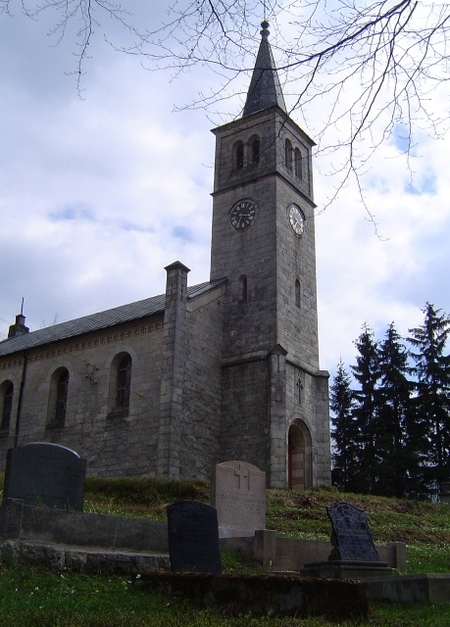
Brick church of the Reformed Church in Pstrążna. Photo: T. Wicherkiewicz.
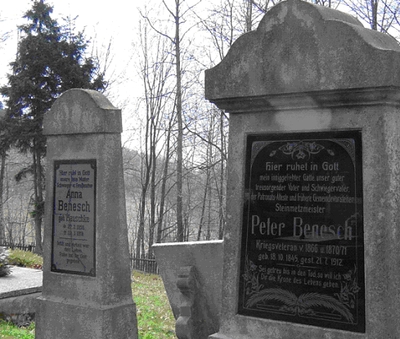
Cemetery in Pstrążna. Photo: T. Wicherkiewicz.
Local Czech dialect was the original administrational language, but in the second half of the 19th century German grew in importance and started to be used in education and the Liturgy (Jabłoński 2002: 119ff
 Jabłoński 2002 / komentarz/comment/r /
Jabłoński 2002 / komentarz/comment/r / Jabłoński, Michał 2002. „Historia Kościoła ewangelicko-reformowanego w Polsce”, w: Bronisław Kamiński (red.) Kudowa Zdrój, miasto i ludzie. Kudowa Zdrój: Stowarzyszenie na Rzecz Rozwoju Miasta Kudowa Zdrój.
 ). At that time, textile industry was the main occupation of the inhabitants of Pstrążna, just like in the majority of Czech settlements. The highest number of residents – 744 people – lived in the village in 1910. Until World War II, Pstrążna was inhabited exclusively by Czech people, but only two Czech families live there now (Balowski 2012: 66f
). At that time, textile industry was the main occupation of the inhabitants of Pstrążna, just like in the majority of Czech settlements. The highest number of residents – 744 people – lived in the village in 1910. Until World War II, Pstrążna was inhabited exclusively by Czech people, but only two Czech families live there now (Balowski 2012: 66f Balowski 2012 / komentarz/comment/r /
Balowski 2012 / komentarz/comment/r / Balowski, Mieczysław 2012. „Postawy Polaków wobec mniejszości czeskiej i Czechów”, w: Lech M. Nijakowski (red.) Czesi, seria „Mniejszości narodowe i etniczne w Polsce”. Warszawa: Wydawnictwo Sejmowe.
 ).
).The first wave of Czech Hussites arrived in Greater Poland in 1434. They were given refuge by Abraham Zbąski, and the following villages were established: Czeskie Stare, Czeskie Nowe (the present day Stefanowice), Łomnica, Chlastawa, and Chrośnica (all of them are situated in Nowy Tomyśl district). However, as a result of a conflict with Catholic bishops, Czech clerics were burnt in front of the local church by local people, and the rest of Czechs were Polonized. However, in 1548, more members of Czech Brethren were brought to Szamotuły by Jan Świdwa Szamotulski. He ordered them to establish the first printing house in Greater Poland; it was active three years later. The next wave of immigrants consisted of refugees after the defeat of the Czech Brethren; they settled down in Leszno and the neighbouring villages in 1628 (Balowski 2012: 67
 Balowski 2012 / komentarz/comment/r /
Balowski 2012 / komentarz/comment/r / Balowski, Mieczysław 2012. „Postawy Polaków wobec mniejszości czeskiej i Czechów”, w: Lech M. Nijakowski (red.) Czesi, seria „Mniejszości narodowe i etniczne w Polsce”. Warszawa: Wydawnictwo Sejmowe.
 ).
).The history of Zelów can be traced back to the 13th century, and the establishment of the village of Szeylów (and later of Zeliów). The first mention about it comes from Liber Beneficiorum, book written by Jan Łaski. The hamlet turned into a typical aristocratic village before the end of the 18th century. The Czech people constituted the majority of the population of the area until the first half of the 19th century, when a considerable group of Czechs moved to Russia, and some of the reminder to Żyrardów. During the next wave of migration, several hundred Czech people from Zelów moved to Czechoslovakia shortly after World War I, in 1922. Moreover, after World War II, as a result of nationalistic, religious and financial conflicts, the number of the inhabitants of Zelów decreased by 3500-4000 people. Also, individual Czechs moved from Zelów to the Czech Republic and major Polish cities.
In 1954, Zelów was given privileges of a settlement, and in 1957 – town privileges (Oszczęda 2010
 Oszczęda 2010 / komentarz/comment/r /
Oszczęda 2010 / komentarz/comment/r / Oszczęda, Waldemar Ireneusz 2010. „Największy ośrodek mniejszości czeskiej w Polsce”, Top – Tygodnik Opoczyński 43 (694). URL: http://www.opoczno-top.pl/artykul,Najwiekszy_osrodek_mniejszosci_czeskiej_w_Polsce,3962.html [dostęp: 15.12.2012 r.].
 ; Šembera 1876
; Šembera 1876 Šembera 1876 / komentarz/comment/r /
Šembera 1876 / komentarz/comment/r / Šembera, Alois Vojtěch 1876. Mnoho li jest Čechů, Moravanů a Slováků v Rakousích a kde obývají. Praga.
 ; Siatkowski 1997: 1636
; Siatkowski 1997: 1636 Siatkowski 1997 / komentarz/comment/r /
Siatkowski 1997 / komentarz/comment/r / Siatkowski, Janusz 1997. „Polnisch-Tschechisch”, w: Hans Goebl et al. (red.) Kontaktlinguistik. Contact Linguistics. Linguistique de contact. T.2. Berlin-New York: Walter de Gruyter, s. 1634-1640.
 ).
).Between 1807 and 1882, ca. 4,000 of Czech people lived in Zelów and the surrounding settlements.
Czech inhabitants of Zelów in 1803–1913 (Tobjański 1994: 39 Tobjański 1994 / komentarz/comment/r /
Tobjański 1994 / komentarz/comment/r /
Tobjański, Zbigniew 1994. Czesi w Polsce. Kraków: Towarzystwo Społeczno-Kulturalne Czechów i Słowaków w Polsce.
 ).
).
 Tobjański 1994 / komentarz/comment/r /
Tobjański 1994 / komentarz/comment/r / Tobjański, Zbigniew 1994. Czesi w Polsce. Kraków: Towarzystwo Społeczno-Kulturalne Czechów i Słowaków w Polsce.
 ).
).| Year | The number of Czech inhabitants | The number of Czech houses |
| 1803 | 500 | 100 |
| 1806 | 710 | 132 |
| 1827 | 735 | 139 |
| 1845 | 1264 | 202 |
| 1855 | 1395 | 206 |
| 1870 | 1846 | 211 |
| 1895 | 2130 | 218 |
| 1913 | 3002 | 361 |
Czech population of villages surrounding Zelów between 1846 and 1860 (Tobjański 1994: 40 Tobjański 1994 / komentarz/comment/r /
Tobjański 1994 / komentarz/comment/r /
Tobjański, Zbigniew 1994. Czesi w Polsce. Kraków: Towarzystwo Społeczno-Kulturalne Czechów i Słowaków w Polsce.
 ).
).
 Tobjański 1994 / komentarz/comment/r /
Tobjański 1994 / komentarz/comment/r / Tobjański, Zbigniew 1994. Czesi w Polsce. Kraków: Towarzystwo Społeczno-Kulturalne Czechów i Słowaków w Polsce.
 ).
).| Town | People / families | |||||||
| 1846 | 1847 | 1851 | 1860 | |||||
| People | Families | People | Families | People | Families | People | Families | |
| Pożdżenice | 57 | 13 | 80 | 20 | 119 | 24 | 35 | 27 |
| Nowa Wola | 24 | 5 | 22 | 4 | 14 | 3 | 23 | 5 |
| Ignaców | 103 | 17 | 30 | 6 | 38 | 10 | 72 | 15 |
| Weronika | 44 | 11 | 5 | 2 | 21 | 6 | 9 | 3 |
| Faustynów | 181 | 34 | 127 | 24 | 95 | 24 | 98 | 16 |
| Józefatów | 103 | 21 | 30 | 11 | 89 | 18 | 62 | 11 |
| Petronelów | 21 | 6 | – | – | 6 | 2 | 3 | 1 |
| Bujny Szlacheckie | 20 | 4 | 16 | 6 | 39 | 9 | 20 | 4 |
Czech population of Łask county between 1939 and 1944 (Tobjański 1994: 168 Tobjański 1994 / komentarz/comment/r /
Tobjański 1994 / komentarz/comment/r /
Tobjański, Zbigniew 1994. Czesi w Polsce. Kraków: Towarzystwo Społeczno-Kulturalne Czechów i Słowaków w Polsce.
 ).
).
 Tobjański 1994 / komentarz/comment/r /
Tobjański 1994 / komentarz/comment/r / Tobjański, Zbigniew 1994. Czesi w Polsce. Kraków: Towarzystwo Społeczno-Kulturalne Czechów i Słowaków w Polsce.
 ).
).| municipality | 1939 | 1942 | 1943 | 1944 |
| Zelów | 3 833 | 2 942 | 3 082 | 2 980 |
| Buczek | 178 | 160 | 158 | 149 |
| Bujny Szlacheckie | 63 | 61 | 57 | 63 |
| Wygiełzów | 150 | 133 | 147 | 153 |
| Kleszczów | 337 | 345 | 345 | 344 |
| Kluki | 12 | 18 | 18 | 18 |
| Łękawa | 5 | – | – | – |
| Widzew | 1 | – | – | – |
| Górka Pabianicka | 1 | – | – | – |
| Dobroń | 1 | – | – | – |
| Chociw | 1 | 2 | – | – |
| Dłutów | – | 1 | 1 | – |
| Szczerców | 2 | 1 | 2 | 1 |
| Utrata | – | – | 7 | – |
| Overall | 4 584 | 3 663 | 3 817 | 3 690 |
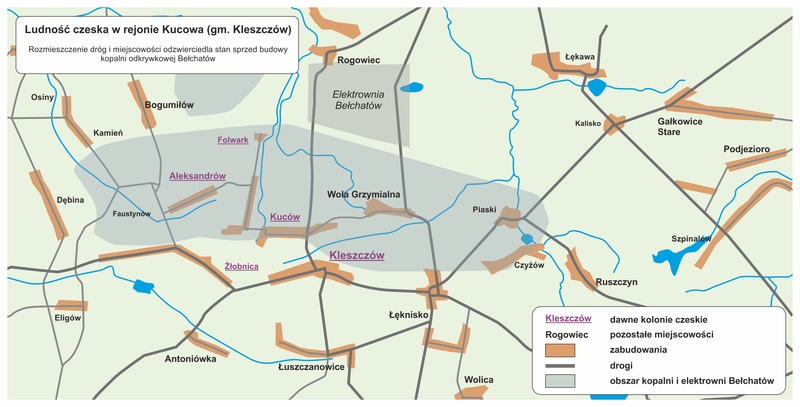
Former Czech settlements in the vicinities of Kuców (map ed.: Jacek Cieślewicz).
Kuców village (in the present day Kleszczów district) was situated 28km from Zelów. In 1847, 9 Czech families (34 people) lived there. Apart from Kuców, a Czech-speaking population lived in the following neighbouring villages: Nowe Talary (5 families – 17 people), Karolów (2 families – 7 people), and Bogumiłów (1 family – 2 people). Because of a high birthrate, 441 Czech people lived in the region: 150 people in Kuców itself, 112 in Żłobnica, 92 in Aleksandrów, 37 in Folwark, and 50 people in the following villages: Kleszczów, Nowe Talary, Karolew and Bogumiłów. During the interwar period, ca. 1000 people lived in Kuców, 2/3 of whom were of Czech origin (Tobjański 1994: 40ff
 Tobjański 1994 / komentarz/comment/r /
Tobjański 1994 / komentarz/comment/r / Tobjański, Zbigniew 1994. Czesi w Polsce. Kraków: Towarzystwo Społeczno-Kulturalne Czechów i Słowaków w Polsce.
 ; Chałupczak & Browarek 2000: 224
; Chałupczak & Browarek 2000: 224 Chałupczak & Browarek 2000 / komentarz/comment/r /
Chałupczak & Browarek 2000 / komentarz/comment/r / Chałupczak, Henryk & Tomasz Browarek 2000. Mniejszości narodowe w Polsce 1918–1995. Lublin: Wydawnictwo Uniwersytetu Marii Curie-Skłodowskiej.
 ; Siatkowski 1997: 1636
; Siatkowski 1997: 1636 Siatkowski 1997 / komentarz/comment/r /
Siatkowski 1997 / komentarz/comment/r / Siatkowski, Janusz 1997. „Polnisch-Tschechisch”, w: Hans Goebl et al. (red.) Kontaktlinguistik. Contact Linguistics. Linguistique de contact. T.2. Berlin-New York: Walter de Gruyter, s. 1634-1640.
 ).
).Czech population in the neighbouring areas of Kuców in 1847-1896 (Tobjański 1994: 41 Tobjański 1994 / komentarz/comment/r /
Tobjański 1994 / komentarz/comment/r /
Tobjański, Zbigniew 1994. Czesi w Polsce. Kraków: Towarzystwo Społeczno-Kulturalne Czechów i Słowaków w Polsce.
 ).
).
 Tobjański 1994 / komentarz/comment/r /
Tobjański 1994 / komentarz/comment/r / Tobjański, Zbigniew 1994. Czesi w Polsce. Kraków: Towarzystwo Społeczno-Kulturalne Czechów i Słowaków w Polsce.
 ).
).| Year | Families | People |
| 1847 | 29 | 120 |
| 1852 | 36 | 131 |
| 1896 | – | 441 |
Czech population in the neighbouring areas of Kuców in 1968 (Tobjański 1994: 187 Tobjański 1994 / komentarz/comment/r /
Tobjański 1994 / komentarz/comment/r /
Tobjański, Zbigniew 1994. Czesi w Polsce. Kraków: Towarzystwo Społeczno-Kulturalne Czechów i Słowaków w Polsce.
 ).
).
In 1954, ca. 2,000 Czech inhabitants lived in Poland altogether (Tomaszewski 1991: 42 Tobjański 1994 / komentarz/comment/r /
Tobjański 1994 / komentarz/comment/r / Tobjański, Zbigniew 1994. Czesi w Polsce. Kraków: Towarzystwo Społeczno-Kulturalne Czechów i Słowaków w Polsce.
 ).
).| Town | The overall number of people | Including the Czech | The % of the overall population |
| Kuców | 335 | 79 | 22,6 |
| Kleszczów | 422 | 6 | 1,4 |
| Żłobnica | 420 | 64 | 15,2 |
| Folwark | 220 | 27 | 12,2 |
| Aleksandrów | 90 | 20 | 22,2 |
| razem | 1 487 | 196 | 13,1 |
 Tomaszewski 1991 / komentarz/comment/r /
Tomaszewski 1991 / komentarz/comment/r / Tomaszewski, Jerzy 1991. Mniejszości narodowe w Polsce XX wieku. Warszawa.
 ; Kwilecki 1963: 98
; Kwilecki 1963: 98 Kwilecki 1963 / komentarz/comment/r /
Kwilecki 1963 / komentarz/comment/r / Kwilecki, Aleksander 1963. „Mniejszości narodowe w Polsce Ludowej”, Kultura i Społeczeństwo, 4: 98.
 ). According to the National Census from 2002, there were 831 members of this minority, while 1126 people spoke Czech at home. The National Census from 2011 showed that there are 2811 Czech people in Poland.
). According to the National Census from 2002, there were 831 members of this minority, while 1126 people spoke Czech at home. The National Census from 2011 showed that there are 2811 Czech people in Poland.Czechs in Poland in 1921 and 1931 – the greatest concentration (Tobjański 1994: 111 Tobjański 1994 / komentarz/comment/r /
Tobjański 1994 / komentarz/comment/r /
Tobjański, Zbigniew 1994. Czesi w Polsce. Kraków: Towarzystwo Społeczno-Kulturalne Czechów i Słowaków w Polsce.
 ).
).
 Tobjański 1994 / komentarz/comment/r /
Tobjański 1994 / komentarz/comment/r / Tobjański, Zbigniew 1994. Czesi w Polsce. Kraków: Towarzystwo Społeczno-Kulturalne Czechów i Słowaków w Polsce.
 ).
).| Colonial region | 1921 r. | 1931 r. | ||
| The census | Other sources | The census | Other sources | |
| Poland – in general | 30 638 | 39 328 | 38 097 | 38 669 |
| Zelów | 1 304 | 3 700 | 3 102 | 4 092 |
| Kuców | 119 | 505 | 529 | 427 |
| Żyrardów | 48 | 190 | 28 | 182 |
| Łódź | 327 | 421 | 370 | 312 |
| Warszawa | 234 | 191 | 226 | 250 |
| Tabor Wielki | 144 | 825 | 765 | 870 |
| Kamienica Polska | – | 5 062 | 7 | 3 927 |
| Kraków | 175 | 560 | 118 | 600 |
| Poznań | 83 | 147 | 63 | 151 |
| Wołyń | 25 405 | 24 852 | 30 977 | 26 392 |
| Other centres | 2 799 | 2 875 | 1 912 | 1 466 |
ISO Code
| ISO 639-1 | cs |
| ISO 639-2 | cze/ces |
| ISO 639-3 | ces |
| SIL | CES |
- przyp01
- przyp02
- przyp03
- przyp04
- przyp05
- przyp06
- przyp07
- przyp08
- przyp09
- przyp10
- przyp11
- przyp12
- przyp13
- przyp14
- przyp15
- przyp16
- przyp17
- przyp18
- przyp19
- przyp20
- przyp21
- przyp22
- przyp23
- przyp24
- przyp25
- przyp26
- przyp27
- przyp28
- przyp29
- przyp30
- przyp31
- przyp32
- przyp33
- przyp34
- przyp35
- przyp36
- przyp37
- przyp38
- przyp39
- przyp40
- przyp41
- przyp42
- przyp43
- przyp44
- przyp45
- przyp46
- przyp47
- przyp48
- przyp49
- przyp50
- przyp51
- przyp52
- Tekst ustawy w literackim języku czeskim
- Tobjański 1994
- Oszczęda 2010
- Gawliczek 2012
- Góral et al. 1987
- Dejna 1990
- Lubos 1974
- Siatkowski 1962a
- Krajewska-Kułak & Łukaszuk 2010
- Tomaszewski 1985
- Solak 2005
- Balowski 2012
- Vaculík 2011
- Policar 2008
- Pałys 2007
- Jabłoński 2002
- Šembera 1876
- Siatkowski 1997
- Tomaszewski 1991
- Kwilecki 1963
- Dejna 1984
- Wróblewski 2012
- Dejna 1981
- Hodura 1925
- Siatkowski 1962b
- Siatkowski 1974
- Bachmannová 2003
- Balowska 2012
- Rospond 1959
- Siatkowski 1996
- Wróblewski 1996
- Wlekły 2008
- Chałupczak & Browarek 2000
- Nijakowski 2012
- Kościak 2012
- Kubin 1913
- Wolska 1980
- Dejna 1983a
- zagrożenie języków / language endangerment
- Czesi w Polsce
- Herb Zelowa
- Zdjęcie domu w Pstrążnej
- Osady czeskie na Wołyniu XIX/XX w
- Czeskie dialekty
- Mapa Prowincji Śląskiej z 1905 r
- III Rzesza - mapa administracyjna terenów Polski
- Kościół ewangelicko-reformowany w Pstrążnej
- Cmenatrz w Pstrążnej
- Okładka monografii J. Siatkowskiego
- Okładka słownika Karola Dejny
- Okładka książki W. Kriegseisena
- Wnętrze zboru w Zelowie
- Tablica w zborze w Zelowie
- Nagrobek w Zelowie
- Husův kámen w Zelowie
- Tekst "Mąż w piecu"
- Tekst "Nasze gospodarstwo"
- Tekst "Prześladowanie ewangelików"
- Dwujęzyczna tablica w Zelowie
- Czesi w okolicach Gęsińca/Husinca
- Ludność czeska w okolicach Kucowa
- Czeski kątek